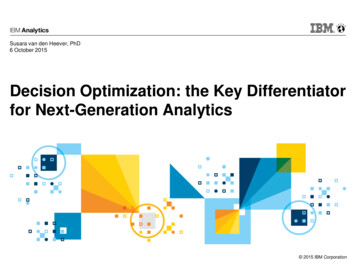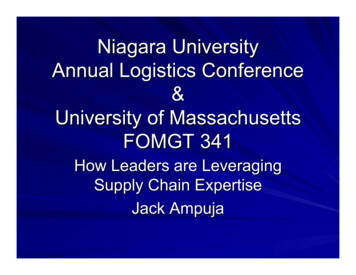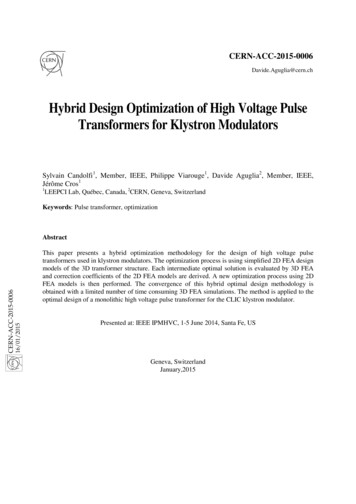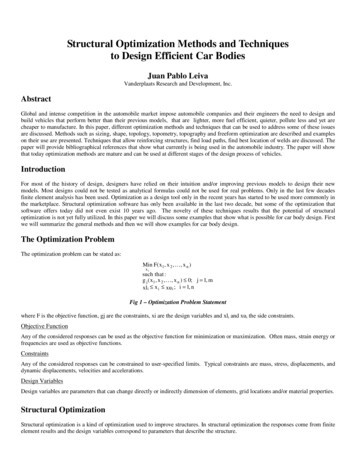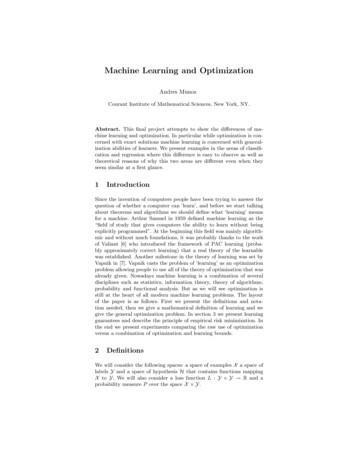
Transcription
Statistical Challenges forGlobal Optimization ExperimentsWilliam HartSandia National Labswehart@sandia.govSandia is a multiprogram laboratory operated by Sandia Corporation, a Lockheed Martin Company,for the United States Department of Energy’s National Nuclear Security Administrationunder contract DE-AC04-94AL85000.
OverviewGoal: Discuss opportunities for applying statistical methods to analyzeand improve algorithms for global optimizationNote:– This presentation is not a review– I am trying to highlight contexts where I think we could developbetter statistical methods– This need is motivated by the fact that statistical methods arerarely used to analyze global optimization methods!Slide 2
The Global Optimization Problemminimizesubject tof ( x)g ( x) 0h( x ) 0x DConsiderations: D may be discrete or continuous or a mixture of both f, g and h may have special structureExamples: convex, multimodal, differentiable There may be several notions of a "local neighborhood"Goal: find a globally optimal point in a robust, efficiently, straightforward, general manner!Slide 3
ExampleDrug Docking Problem: find the optimal binding for a small ligand in a binding site Application: lead compound development Impact: limit laboratory experimentation required to develop newdrugsSlide 4
Flexible Drug Docking in AutoDockIdea: dock a small flexible ligand into a static binding siteSearch Dimensions: Cartesian Coordinates (3 dimensions) Quarternion (unit vector plus rotation angle) Torsion anglesFormulation: Nonsmooth energy potential– Standard energy model: electrostatic,van de Waals, Hydrogen bonds, etc– Trilinear interpolation of atomic interactions Simple bound constraints Unit-length quarternion constraintNote: Binding constraints or ring constraints possibleSlide 5
Algorithmic Techniques Used for GOBox decomposition Interval methods, MILP, DIRECT, Lipshitzian searchPopulation search EAs, scatter search, controlled random search, differentialevolutionResponse surface modeling Minimize surrogate functions, maximize expected improvement, etcGlobal-local search Multistart-LS, memetic EAs, GRASP, clustering/topographicalmethodsIterated local search Simulated annealing, tabu search, ant systemsSlide 6
Exact Optimization: Branch and BoundIdea: Subdivide the search domaininto non-overlapping regions Ranked regions with estimatesof their best value Subdivide regions in order oftheir rankoriginal problemxi 0xj 0xj 1xi 1xk 0Practical Issues: Terminate with exact/approximate solution in finite time Too slow for large applications Ranking/bounding techniques are not available for complexapplicationsSlide 7xk 1
Global-Local SearchIdea: Generate initial points from a fixed distribution Apply domain-specific local search methods to refine solutions Asymptotically guarantees convergence w.p.1Practical Issues: Weak stopping rules have been developed (e.g. Hart ‘99) This a standard benchmark method This can be improved by partitioning the random samplesSlide 8
Global-Local Search(cont’d)GRASP: Multistart technique with semi-greedy initialization Semi-greedy approach– Greedy function: evaluates the value of augmenting the currentpartial solution– Semi-Greedy: rank augmentations, and pick randomly from among thebest H percentCluster/Topological Methods: Idea: limit the total number of local searches Identify local search seeds from random samples– Cluster: apply quick local search, cluster, seed LS with cluster center– Topological: apply local search to points that are ‘downhill’ fromsufficiently many nearby points Note: clustering methods can provably require finitely many LSs!Slide 9
Response Surface ModelingIdea: Model the objective function and/or constraints using response surfaces Analyze/optimize the response surface to identify trial points Evaluate these trial points and update the response surface model Note: very effective for applications with expensive objective/constraintfunctions Note: also effective at smoothing out numerical ‘noise’Bayesian Methods: Stochastic model of possiblefunctions that match the data points Analyze both the function value andmodel uncertainty Select a point to maximize theprobability of improvement overthe best point seen so farSlide 10
Response Surface Modeling(cont’d)Example: Explosives Placement Goal: maximize the size of a cavity created by explosives Constraints: cost, placement time Very noisy, expensive simulation required to evaluate each trialpointApplication: demolition, miningSlide 11
Iterated Local SearchIdea: Algorithmic frameworks for local search– Define neighborhood search operator– Define restart mechanism– Define solution similarity metricNote: Easily customized to new problem domains Often find better local minima than canonical local search methods Often randomized– e.g. adaptive/biased sampling methods Often inspired by natural processesSlide 12
Iterated Local Search(cont’d)Simulated Annealing: A probabilistic local search procedure inspired by physical coolingprocesses– A trial point is sampled from a local neighborhood– The point is accepted or rejected using a probabilistic criterion– The acceptance criterion is updated so that accepting a worsepoint is less probable in the next round. If the probability of rejection is ‘cooled’ sufficiently slowly thensome variants of simulated annealing provably converge inprobability.Ant Colony Optimization: Inspired from collective behaviors in ant colonies Ant reinforcement strategies can be tailored to solve optimizationproblems– Both local and global reinforcement Note: well-suited for a variety of graph-based combinatorialproblemsSlide 13
Population SearchIdea: Maintain a set/population of points in each iteration Generate new points with– Local steps about points– Recombination steps using two or more ‘parents’ Keep the ‘best’ points seen so farGenetic Algorithms: A general population-based meta-heuristic Exploits interplay between exploration and exploitation– Global sampling: cross-over between diverse solutions– Local sampling: mutation around solutions– Various randomized selection strategies to subselectionsolutions in each iteration (generation) Can use local searchSlide 14
MetaHeuristics?Idea: a framework for defining optimizationExamples:– Genetic algorithms– Tabu search– GRASP– Simulated AnnealingNote: you could include others here as well– Branch-and-bound– Sequential quadratic programmingSlide 15
Analysis of Global Optimization MethodsConvergence theories look like:– Let X t be the stochastic process defined by the best pointfound by the global optimizer in each iteration– For any suitably chosen function f(), f(X t) - f* withprobability one, where f*OR– In a finite number of iterations, f*-f(x t) εThese are asymptotic results that have little practical relevance.Slide 16
Analysis and Comparison of Global OptimizersExperimental comparisons are the standard approach to analyzingglobal optimizers– Complex algorithms– Little distinction between software and algorithmQ: which code works better for my application?Typical analysis:– Run two or more optimizers on a finite set of test problems– Terminate optimizers after a fixed time limit– Compare values of best solutions Worst, Mean, Median, MaxSlide 17
Overview of Statistical ChallengesStatistical Methods for OptimizationEstimating Solution TimeAccounting for Optimizer VariabilityAssessing Optimizer ScalabilityLarge-Scale Performance ComparisonSlide 18
Statistical Methods for OptimizationThe most common comparison is between the mean performance oftwo or more optimizers– Typically a comparison of mean solution values after a givenlevel of effort (runtime or function values)Problem: Hypothesis testing is still not widespread– Statistical methods are rarely used in optimization articlesPossible explanations:– Many optimization researchers come from disciplines that arenot strongly experimental– The complexity of statistical methods is an issue for many users– There are a variety of gaps between classic experimentalmethods and methods needed for computer experimentsSlide 19
Idea: A Process For Model ValidationObservation: Statistical text books and tutorials typically focus onmethods (hypothesis tests, regression, etc)Problem: model validation is an important issue for computationalexperiments– It can be difficult to predict the distribution of data– Bimodal distributions are not uncommon when characterizingoptimizer behaviorChallenge: develop experimental best-practices– This is more than just developing techniques– This is about developing processes that are easy to followSlide 20
Example: An experimental sequential analysisThe steps in this analysis have beendescribed by many authors Ridge and Kudenko 20061. Check blocking2. Check correlation3. Note Best Responses but this process has not been4. Find important effectssocialized within the optimization5. Rank Important Effectsresearch community6. ANOVA test7. Model Diagnosis:normality, constant variance, etcText books and papers on statistical8. Model poweranalysis focus on methods9. Model significance10. Model ReductionA key challenge is to guide users when 11. Model Fita textbook analysis is not sufficient 12. Examine AliasingSlide 21
Possible Next Steps Better tools for computational experimentation– Idea: implement this sort of statistical analysis for typicalexperimental contexts Explanatory descriptions of results– Idea: tools to automate the evaluation of statistical models Example: the use of data transformations It does not really matter if these are computationallyexpensive Books and tutorials that focus on the process of statistical analysis– Idea: assume reader is familiar will statistical methods– Goal: describe the process of statistical analysis– Example: The Little LISPer A clear, simple, interesting, and complete book thatsuccinctly teaches the reader how to use LISPSlide 22
Estimating Solution TimeGoal: find a globally optimal (or near-optimal) solutionProblem: it is difficult to predict how long a global optimizer willneed to solve a problem– Complex applications may require “too many” optimizationiterations– Randomized optimizers have runtime distributions with fat tails– Heuristic optimizers typically have weak stopping criteriaImpact: optimization data is often right censored– Optimizers are often terminated after a specified time limit– The final solution value can be assessed– Cannot assess the time needed to find a near-optimal solutionfor all experimental trialsSlide 23
Idea: Leverage Survival AnalysisCan we apply survival analysis techniques developed for the biologicaland medical sciences?How can survival functions, hazard functions and mean residual lifefunctions inform our selection of optimizers?Can we expect that these will be similar for different types ofoptimizers?Can we compare multiple algorithms with these methods?Slide 24
Restarting OptimizersObservation:– The search in heuristic optimizers can stagnate and fail tosearch globally– Restarting heuristic optimizers with new initial conditions canbe a more effective search strategy in many contextsQ: can survival analysis inform the design of restart methods?Example: Hoos and Stutzle, 2000– Empirical analysis of iterated local search for 3SAT– Demonstrate that the runtime distribution to find a solutionwith a given value is exponential– Thus, restart methods are not useful for these optimizersSlide 25
Idea: Adaptively Estimate Median RuntimeProblem: optimizer runtime distributions often have thick tails– Estimating mean runtime can be expensive– Estimates of mean with right censored data are suspectIdea: estimate median runtime in an iterative manner– Iteratively estimate bounds on the estimate– Truncate optimization runs beyond these bounds to minimizecompute timeGoal: estimate median performance without performing lengthyoptimizationsSlide 26
Algorithmic IssuesBounds:– What type of bounds should be used?– Are these tight enough to make this practical?– Should we bound the median, or a larger percentile We can get tighter bounds on the 75th percentile, but thatmight cost moreRestarts:– Should we restart truncated optimization trials, or pick newtrials?Analysis:– Can we predict the expected cost of this process?– CS methods can be used, but they are asymptotic in thenumber of samples Slide 27
Accounting for Optimizer VariabilityOptimization studies are increasingly comparing runtime differenceswith cumulative “solvability” plots% of Problems Solved1000Level of EffortSlide 28
Evaluating OptimizersProblem: these plots do not adequately describe the variability ofoptimizer runtimesWe do not simply want the optimizer with the best mean performance– Potentially long runtimes are very undesirable to usersProbability10Runtime to solve a problemSlide 29
Idea: Robust Performance AssessmentChallenge: account for solver variability as a separate design criteriaIdea: treat algorithmic comparison as a bicriteria assessment– Characterize mode and variability– Would the goal be to identify optimizers with nondominatedstatistics?– How could we leverage existing statistical techniques?Idea: perform statistical comparison with robust statistics– Example: compare extreme statistics– Do robust statistical methods exist for these measures?Slide 30
Assessing Optimizer ScalabilityObservation: large, real-world problems are often quite differentfrom test problemsChallenge: efficiently compare the scalability of optimizersSlide 31
Example: Fraction of Problems Solved – 10 minutesNote: the experimental runtime is dominated by trials in which theoptimal solution is not found!Slide 32
Example: Fraction of Problems Solved – 30 minutesSlide 33
Idea: DOE for ScalabilityIdea: Treat scalability as a factor Can we design experiments that treat runtime as a separate controlvariable and then analyze this dimension? Can we perform “paired” experiments and adaptively truncate them atdifferent final solution values?Idea: Adaptive experiments that terminate optimizers when a near–optimalsolution is found Can we treat this as a method for generating right censored data?– Idea: run different experiments with different thresholds Can we leverage this to assess scalability questions?Slide 34
Scalability of Exact SolversFor exact solvers, we can usually only solve a fraction of the problemsto optimalityExact methods can determine that an optimal solution is foundThus, we have data on the runtime to solve problems, and rightcensored data with final solution valuesHow do we integrate this data into a quantitative comparison?Are there better summary methods than the cumulative performancegraphs?– e.g. methods like decision trees might better summarizerandomized optimizersSlide 35
Example: Assess Gap with Known Global MinimumSlide 36
Large-Scale Performance ComparisonChallenge:– Optimizers can have lots of tunable parameters– Researchers often want to run them on many test problems– Randomization is a common feature– Some optimizers are influenced by environmental factors E.g. parallel methods can be intensity nondeterministic– Performing global optimization on a single problem can beexpensiveGoals:– Identifying key algorithmic parameters– Optimizing algorithmic parameters– Design and analysis of optimization experimentsSlide 37
1. Identifying Key Algorithmic ParametersObservation: optimizers can have lots of tunable parameters– Search options: control how search is performed– Algorithmic parameters: control behavior of search optionsExample: hybrid genetic algorithms– Crossover type: uniform, two-point, none Crossover rate– Mutation type: normal, Cauchy, uniform Mutation rate, scale– Local search type: pattern search, quasi-Newton Step scale, step toleranceSlide 38
Idea: Experimental DesignWhat are best practices for experiment designs to identify keyparameters?– This is not an uncommon practice– Not often a focus of researchResearch Challenges:– Methods that can design experiments with mixed-levels– Methods that can address nesting of algorithmic parameters– Methods that work well for 10s-100s of parametersExample: Xu, 2002– Heuristic for constructing nearly-orthogonal arrays– Generated arrays with mixed-levels and few runsSlide 39
2. Tuning Optimizer ParametersObservation: researchers typically tune their algorithmic parametersby hand (or not at all)Challenge: tune parameters to maximize performance while not overfitting to the problem test set– Need to account for optimizer variability– Need to account for generalization– May need to account for multiple performance criteria Runtime, final value, etc– May need to handle both discrete and continuous parametersSlide 40
Idea: Experimental DesignUse fractional factorial designs to sample intelligentlyStatistical analyses of variance and parameter interactionsSlide 41
Fractional Factorial Designs For TuningIdea: treat tuning as an experimental analysis(Enda and Kudenko, 2007) Discretization of tuning parameters– Hi/Low values Experimental design on few parameters– 2IV12-5 fractional factorial design– 8 replicates and 24 center points– Randomly generated test problems Problem variability was a factor Analysis with ANOVANote: the response surface exhibits curvature, so predictions fromthis linear model need to be made with cautionSlide 42
Idea: Stochastic OptimizationThese methods use– Fractional factorial designs help sample intelligently– Model-based analyses help minimize the number ofexperimentsBut this is fundamentally a stochastic optimization problem– Need to find interesting parameters– Need to validate that it has better performanceChallenges:– How model both discrete and continuous parameters?– How can we account for generalization beyond the test set?– How can we tune with multiple performance criteria?Slide 43
CALIBRAIdea: use Taguchi’s fractional factorial experimental designs coupledwith local search (Adenso-Diaz and Laguna, 2006)1. Perform initial experiments to determine best/worst values foreach parameter2. Perform local search Select initial values from initial experiments Perform Taguchi L9(34) experiment with these values Update values and iterate Terminate when no improving values are found3. Possibly perform multiple local searchesNote: implementation of CALIBRA appears limited to few parameters,but it could be generalizedSlide 44
Sequential Parameter OptimizationIdea: minimize cost of tuning by using DACE techniques(Bartz–Beielstein et. al. 2005)1. Select initial points with LHS Round to generate integer values Use repeated trials2. Fit a second-order polynomial model with trial data3. Select new points using this model Use LHS again to generate many points Select points with the highest likelihood of being better thanthe best4. Iterate Increase number of random trialsNote: this approach is probably not well-suited for binary parametersSlide 45
F-raceIdea: iteratively focus comparisons on statistically promisingparameters (Birattari et.al. 2004)1. Select a fixed set of parameter configurations with a full-factorialdesign2. Iteratively Run configurations on new test problems Eliminate a configuration if it is statistically inferior to atleast one other configuration Friedman two-way analysis of variance by ranksIdea: an iterative version of F-race has been developed to avoid theinitial full-factorial analysisNote: F-race requires discretization of parametersSlide 46
Tuning – Final Thoughts Authors of these methods fail to make comparisons– Is there a clear metric for evaluating a tuner?– These look like quick-and-dirty stochastic optimizers These methods do not explicitly consider different performanceobjectives: time to solution and reliability of solver Solving mixed-continuous tuning remains a challenge It’s not clear how to avoid overfiting a test-set with these methods Nested parameter choices remains a key challenge– This is directly related to experimental algorithmic designSlide 47
3. Optimization ExperimentsSuppose the we have– selected a set of key parameters and– tuned parameters for our optimizer then, we are still left with the challenge of designing anexperiment to compare this with other optimizersChallenge:– There can be lots of test problems– Pseudo-random and random effects need to be controlledSlide 48
Problem FactorsA fixed set of test problems– We want optimizer to work well on all possible problems– Test problems represent a sample from a distribution ofpossible optimization problemsNote: can treat test problems as a random effect– This does not appear to be widely recognizedHow does this impact the design and analysis of experiments?– Blocking of problem factors is common– This is typically done by treating problems as a nuisance factor– Can we use design of experiments with incomplete blocking?Slide 49
Idea: Analysis with Random EffectsGoal: use random and mixed-effects models to leverage the fact thatproblem factors are randomWhat additional modeling assumptions need to be verified?Do we need to validate the randomness of this factor?What additional information can be inferred from these models?– E.g. understand how variances change with problem sizeSlide 50
A Motivating Example?I tried to use a mixed-effects model, but the data was significantlynon-normal/Slide 51
Related Statistics Problems DOE for software testing– Goal: explore many algorithmic combinations to test a large fractionof the optimization software– Note: cannot reduce size of experimental design a priori Multivariate analysis– Goal: compare optimizers that have multiple performance criteria– Example: explore runtime/performance tradeoffs in heuristicoptimizers with stopping rules Comparison of multi-criteria optimizers– Goal: compare the Pareto sets generated by multicriteria optimizers– Note: methods for comparing Pareto sets is an open research areaSlide 52
Hey,Hobbs.Here's A mathproblem IHAVE ToFigure Out.Slide 53Ooh.That’s a tricky one .You have to usecalculus and globaloptimizationfor this.You know ,globaloptimization branch and?!!?bound,tabusearch,andall those .It’s a littleconfusing atfirst.HOW DID YOU INSTINCT.Learn allTigers arethis? You've born w ithnever even It.GONE toSCHOOL!
Statistical Methods for Optimization The most common comparison is between the mean performance of two or more optimizers - Typically a comparison of mean solution values after a given level of effort (runtime or function values) Problem: Hypothesis testing is still not widespread - Statistical methods are rarely used in optimization articles





